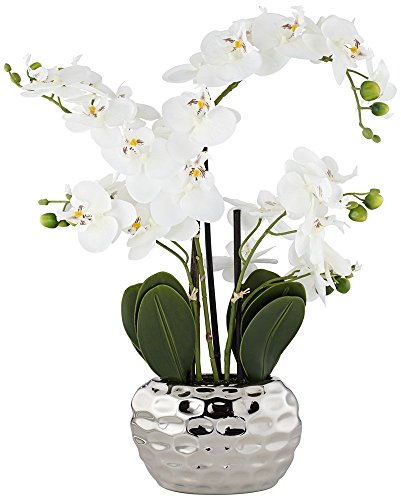Hi Charles,
Thanks for your insights regarding judging. If more people questioned why we judges do things the way we do, the system would be stronger. You bring up two interesting but separate issues here:
1) Judging Criteria as they apply to hybrids.
2) "Improvement" of the species through line-breeding.
1) When we judge hybrids, we must take into consideration what each of the
parents contribute in terms of color, form, size and floriferousness.
We then apply certain judging criteria to these characteristics to
determine whether the hybrid we're looking at represents an "improvement"
over the parents. This is not always an easy thing to do, especially if one
of the parents (P. kovachii) is spectacular in it's own right. And it is true
the judging criteria tend to favor those flowers that are rounder and fuller
than the parental stock. Unfortunately, this artificial application of a
trait that is considered "better" by human standards can lead us astray
unless we do the research necessary to really understand the breeding.
Let's face it; P. kovachii has some negative traits. The flowers fade, they
are ephemeral and the form changes as the flower matures. If these traits
are exhibited in it's hybrids, which is what we have seen in some of it's
hybrids so far, the probablility of a large number of awards to F-1 Pk
hybrids is slim - at least on the basis of current judging criteria.
2) As far as "improvement" of the species through line breeding, I couldn't
agree with you more. If we continue on this path of applying the "toward
roundness and fullness" criterium to (in this case) every slipper orchid
species, regardless of it's original form, pretty soon everything will look the
same and we will have undone thousands of years of species evolution in
the process by creating something that does not exist in nature. I call
this hybridization of the species and I'm not in favor of it. As an example,
look at the cover photo on Cribb's Vol. 1 "The Genus Paphiopedilum". It is
one of the best renditions of Paph. sukhakulii I've ever seen. Sadly, if we
applied our current criteria to it, it would have a hard time getting an AOS
award today, even though it is beautiful.
Thanks again for your input, Charles. I should add that my views on these matters are not necessarily the views of other AOS judges nor are they meant to create controversy as regards the AOS judging system.
Thanks!
Thanks for your insights regarding judging. If more people questioned why we judges do things the way we do, the system would be stronger. You bring up two interesting but separate issues here:
1) Judging Criteria as they apply to hybrids.
2) "Improvement" of the species through line-breeding.
1) When we judge hybrids, we must take into consideration what each of the
parents contribute in terms of color, form, size and floriferousness.
We then apply certain judging criteria to these characteristics to
determine whether the hybrid we're looking at represents an "improvement"
over the parents. This is not always an easy thing to do, especially if one
of the parents (P. kovachii) is spectacular in it's own right. And it is true
the judging criteria tend to favor those flowers that are rounder and fuller
than the parental stock. Unfortunately, this artificial application of a
trait that is considered "better" by human standards can lead us astray
unless we do the research necessary to really understand the breeding.
Let's face it; P. kovachii has some negative traits. The flowers fade, they
are ephemeral and the form changes as the flower matures. If these traits
are exhibited in it's hybrids, which is what we have seen in some of it's
hybrids so far, the probablility of a large number of awards to F-1 Pk
hybrids is slim - at least on the basis of current judging criteria.
2) As far as "improvement" of the species through line breeding, I couldn't
agree with you more. If we continue on this path of applying the "toward
roundness and fullness" criterium to (in this case) every slipper orchid
species, regardless of it's original form, pretty soon everything will look the
same and we will have undone thousands of years of species evolution in
the process by creating something that does not exist in nature. I call
this hybridization of the species and I'm not in favor of it. As an example,
look at the cover photo on Cribb's Vol. 1 "The Genus Paphiopedilum". It is
one of the best renditions of Paph. sukhakulii I've ever seen. Sadly, if we
applied our current criteria to it, it would have a hard time getting an AOS
award today, even though it is beautiful.
Thanks again for your input, Charles. I should add that my views on these matters are not necessarily the views of other AOS judges nor are they meant to create controversy as regards the AOS judging system.
Thanks!














































